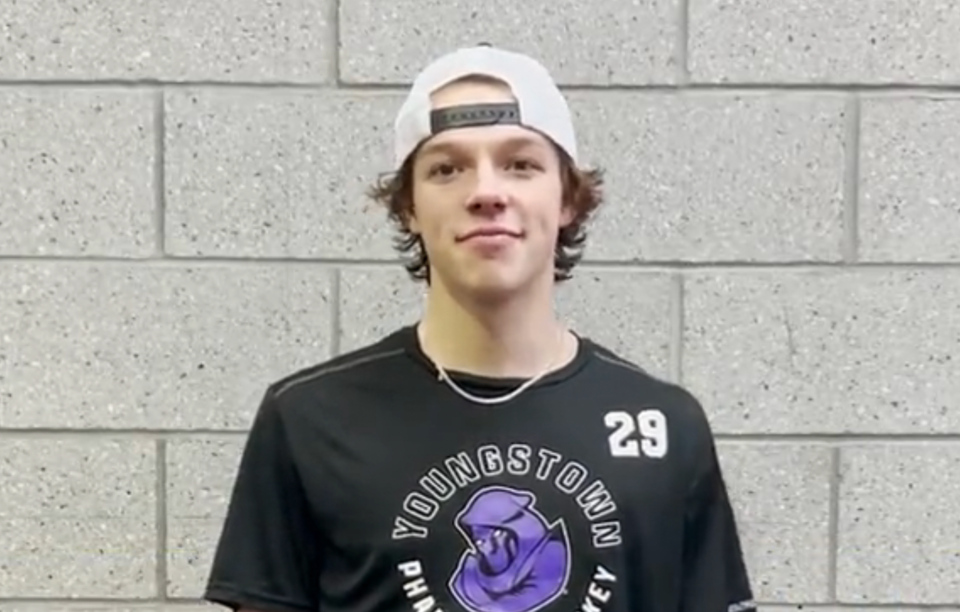The Vancouver Canucks kicked off their three fourth-round picks with an over-age forward, drafting 20-year-old centre Ty Mueller 105th overall.
They finished off their fourth round with another over-age centre at 119th overall: 19-year-old Matthew Perkins.
Players drafted in their second or third years of eligibility are typically coming off breakout years where they give scouts a reason to overlook their age. That doesn’t really seem to be the case for Perkins, who was well under a point-per-game in the USHL.
Perkins had 15 goals and 44 points in 60 games for the Youngstown Phantoms, landing him 51st in the USHL in scoring. He followed that up with just 2 points in 9 playoff games. As much as points aren’t everything in assessing a prospect, it’s a troubling indicator for a forward that the rest of his game might not project to be NHL caliber.
Accordingly, Perkins wasn’t ranked by any public draft ranking, though NHL Central Scouting put him at 165th among North American skaters.
So, what made the Canucks draft Perkins in the fourth round? Most likely, it was his intelligence, which makes up for a lot of other deficiencies in his game.
“The skating and hands are lacking, but he’s NHL smart,” said Elite Prospects’ Mitchell Brown in one scouting report, even as he admitted that he didn’t see him as a pick in this draft. “He has the intelligence to surprise if the mechanics come along.”
Perkins’ play away from the puck is notable, both offensively and defensively, as he has a good read on where to be on the ice in any given situation. That allows him to be a playmaking connector offensively, as he works give-and-goes and finds open ice for himself and his teammates.
While listed as a centre, Perkins can also play on either wing and added penalty killing to his resume with the Phantoms, making him a well-rounded, versatile player.
"The NHL team that gets Matt is going to get a very coachable, driven player," said Phantoms head coach Andy Contois. "His teammates love him, he's a great leader, and he has the ability to have a ton of success in the future."
Elite Prospects gave Perkins an “F” grade in their draft guide but left some room for optimism because of his intelligence.
“Awareness and intelligence drive Perkins’ game,” reads their scouting report. “He gets open for chances, skates his routes to create openings for teammates, and pickpockets opponents. Instead of relying on overwhelming pressure, he uses subtle nudges and well-timed pokes and stick lifts to win possession. From there, he looks to the slot for a pass, connecting off either side of his blade.”
The trouble for Perkins is that his skillset does not allow him to leverage his intelligence effectively.
Despite a strong work rate, Perkins’ skating stride is evidently problematic and it makes everything else that much harder for him.
“He’s a very limited skater – wide stride, high hips, dropped chest, limited power on his recoveries,” said Brown in one scouting report. “Pass receptions and puckhandling are tricky for him with his changing skating depth. Constantly fighting the puck.”
The gamble for the Canucks, then, is that this element of Perkins’ game is fixable. If he can overhaul his skating mechanics — no small task — then his intelligence could turn him into a valuable two-way player in the NHL.
Making things harder for Perkins is that he isn't the biggest player. He's listed at 5'11" and 156 lbs by the Phantoms, which makes it all the more important that he sorts out his skating stride.
It’s a long shot and Perkins is clearly a project. It’s fair to question whether the Canucks could have taken a prospect with more potential and higher upside at this point of the fourth round, especially since no one in the public sphere seemed to feel that Perkins was worth drafting.
Perkins is on his way to the University of Minnesota-Duluth, which gives him a long development path, as he can stay in the NCAA for up to four years without the Canucks losing his rights. That gives the Canucks some time to see if their gamble on Perkins’ intelligence will pay off.




